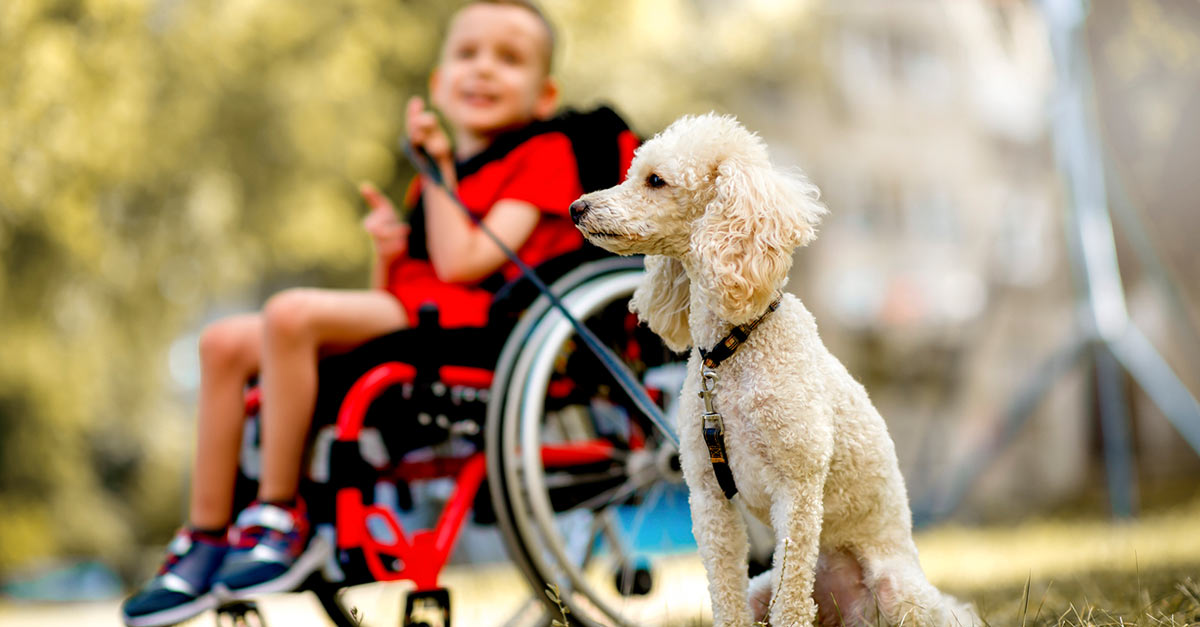Service and emotional support animals for cerebral palsy patients

Research shows that animals can improve children’s physical independence and emotional well-being. Below, we explain the difference between service and emotional support animals and how each may be able help children with cerebral palsy.
Service vs. emotional support animal: What's the difference?
Even though both types of animals help people with disabilities, they each have a unique purpose and are recognized differently by the federal government.
Service animals perform tasks that are directly related to the person's disability. The Americans with Disabilities Act (ADA) defines a service animal as “a dog that has been individually trained to do work or perform tasks for an individual with a disability.”
Dogs are the only species recognized as service animals under the ADA.
Anyone with a disability — including children — has the right to bring their service dog to most public places, such as schools, stores, and restaurants.
There are at least 500,000 service dogs working in the U.S. today.
According to the U.S. Department of Housing and Urban Development (HUD), an emotional support animal (ESA) is “any animal that provides emotional support that relieves one or more symptoms or effects of a person’s disability.”
Emotional support animals provide companionship, relieve loneliness, and can help with anxiety and depression, but they do not have special training to perform physical tasks that assist people with disabilities.
Emotional support animals may be any type of pet, like a cat, dog, rabbit, or bird.
Because emotional support animals are not covered by the ADA, it is up to individual businesses and institutions whether to allow them inside their facility. However, ESAs do have legal protections when it comes to housing.
The Fair Housing Act prevents landlords, condominium boards, and homeowners’ associations from banning emotional support animals or charging pet fees and deposits.
You may be required to provide written documentation, such as a letter from a mental health professional, confirming your child’s mental health condition to ensure your support animal receives these legal protections.
To recap, here are the key differences between service and emotional support animals:
| Service Animal | Emotional Support Animal |
|---|---|
| Performs physical tasks, such as opening doors or pulling a wheelchair, to assist someone with a disability | Offers emotional comfort to someone with a disability through their presence and companionship |
| Can only be a dog | Can be any type of pet |
| Trained to perform specific tasks | Not specially trained |
| Legally allowed in all “public accommodations,” including schools, stores, restaurants, libraries, etc., under the ADA | Protected under the Fair Housing Act but not the ADA; may be excluded from public and private places |
How service animals can help children with cerebral palsy
Service dogs can help children who have mobility limitations caused by cerebral palsy. This could include helping with basic tasks such as opening and closing doors.
Service animals can also assist a child with cerebral palsy by:
- Alerting a parent or other adult if the child needs attention
- Helping move the child move from their wheelchair to a bed or toilet
- Offering balance support
- Providing calming pressure across the child’s lap or body
- Pulling a wheelchair
- Pushing elevator buttons
- Recognizing and responding to a seizure or other medical emergency
- Responding to hand signs or sign language if the child is nonverbal
- Retrieving dropped or hard-to-reach objects
- Turning light switches off and on
Service dogs can also serve as a sort of social “bridge,” helping children diagnosed with cerebral palsy and other movement disorders more easily communicate with their peers.
How emotional support animals can help children with cerebral palsy
Studies show that children with cerebral palsy are at higher risk for mental illness and psychological problems such as depression and anxiety.
They also have higher rates of neurodevelopmental disorders, including autism spectrum disorders (ASD) and attention deficit hyperactivity disorder (ADHD).
If your child has cerebral palsy and experiences mental health issues, an emotional support animal may help them live a more comfortable and stress-free life.
Benefits of emotional support animals include:
- Diminishing stress
- Enhancing social engagement and interaction
- Increasing mental stimulation
- Lowering anxiety
- Normalizing heart rate and blood pressure
- Providing an escape or happy distraction
- Reducing pain
- Relieving loneliness
How to find a service animal for your child
The current demand for service animals outweighs the supply of properly trained dogs. Getting a service dog can take months — or even years — so it’s important to make sure this is the right decision for your family.
Since many service dogs are larger in size, like golden retrievers and Bernese mountain dogs, apartment or condo living may not be ideal. There may be an inspection done to ensure your home is suitable for a service animal.
If your child has been diagnosed with cerebral palsy and you’ve determined they would be a good candidate for a service dog, the best place to start is by researching nonprofit service dog organizations.
Nonprofit organizations can help you find a dog that best meets your child’s needs. They will also typically cover the cost of training through grants and fundraising.
Organizations that can help you find a service dog include:
- 4 Paws for Ability
- Assistance Dogs International
- Canine Companions
- Canine Partners for Life
- Duo Dogs
- Paws With a Cause
- W.A.G.S. 4 Kids
These organizations provide service animals directly or can refer you to a local group that does.
